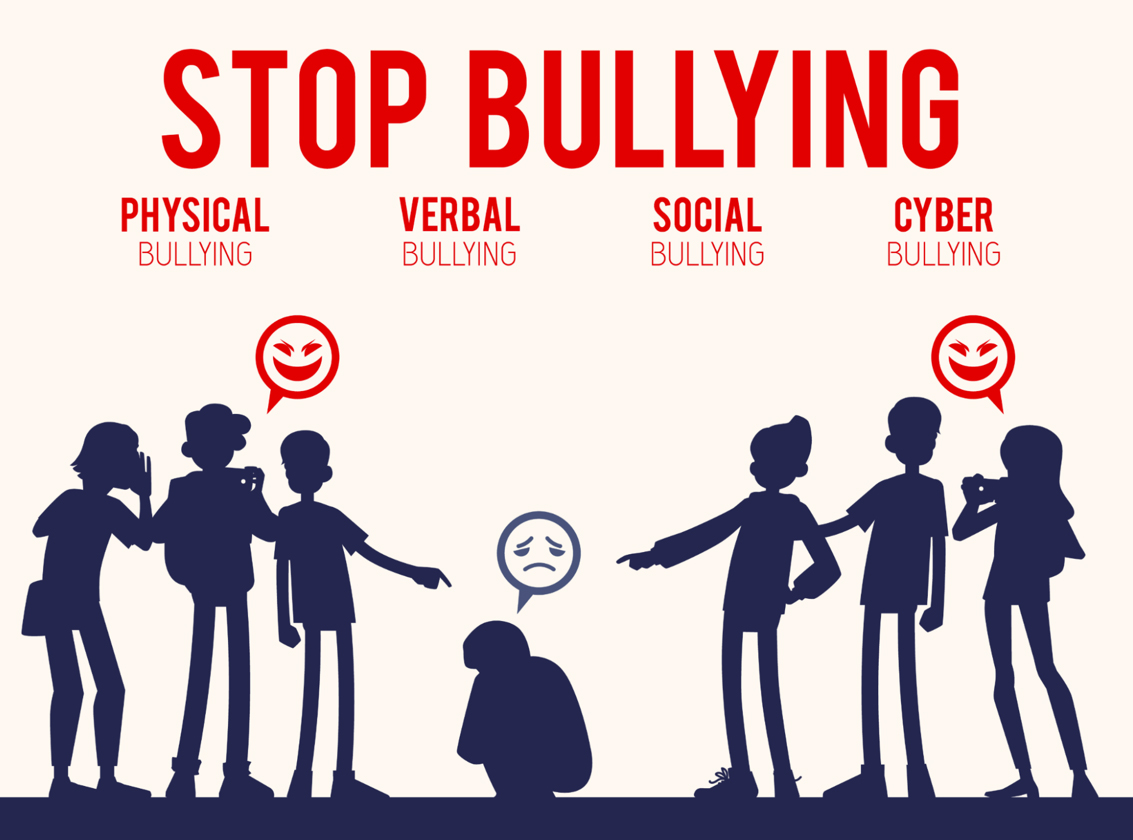Childhood and adolescence can be a time for new experiences, identity-seeking, and lasting friendships. School-aged children go through all types of physical, intellectual, social, and emotional development. While there are many positive aspects to being young, there are also many risks that can be associated with it, including bullying/cyberbullying.
What is Bullying?
According to the 2019 Indicators of School Crime and Safety, about 20% of students between the ages of 12-18 have experienced bullying nationwide.1 Bullying is unwanted, aggressive behavior among school aged children that involves a real or perceived power imbalance. The most common types of bullying are verbal intimidation, physical assault, and psychological abuse. Actions, such as name-calling, teasing, threatening to cause harm, spreading rumors, embarrassing someone in public, hitting, spitting, pushing, taking, or breaking someone’s things, making mean or rude hand gestures, or excluding someone from a group on purpose are all examples of bullying.2 Bullying can happen in person and electronically, known as cyberbullying, at school, or in other settings.
Cyberbullying: what it looks like now & social media
Cyberbullying is bullying that takes place over digital devices. Nowadays, cyberbullying can be more harmful than in-person bullying because it can happen anywhere at any time. Making and posting a false profile of someone, insulting them, sending them sexual notes, or threatening them using internet devices like cell phones, tablets, and computers are all considered cyberbullying. The content any individual shares online – both their personal content and any negative or hurtful content – creates a permanent public record of their views, activities, and behavior.3 Usually, those harmful characteristics take place on social media such as Facebook, Instagram, TikTok, gaming communities and online forums, chat rooms, and message boards.
Some reasons students bully others include revenge, anonymity, weakness, power, and peer influence. Many of them were cyberbullied previously that’s why they engage in cyberbullying, others fear of being caught may motivate them to use the internet to bully victims, and other bullies are either younger or physically weaker than their victims.4 These reasons could prompt individuals to engage in cyberbullying and subsequently avoid physical reactions by the victims. Hidden identities may become enjoyable to the bullies themselves. Other students may form a group whose main mission is to intimidate others. It is a powerful force that drives individuals, both young and old, into falling into peer pressure to partake in it.4 Cyberbullying might have a bigger harmful impact nowadays on adolescent psycho-emotional health.4 Permanence and publicity of online harassment render is particularly damaging.
The Impact of Cyberbullying
 Cyberbullying have irreparable damage on their victims. The exposure of online harassment in comparison to other forms of bullying makes it tenacious and its effects are harder to alleviate. The experience of being bullied can cause lasting, sometimes permanent mental health damage, development of stress disorders, substance use, and suicide4. Those who are bullied can experience major effects until they become adults. Some consequences include depression, anxiety, increased feelings of sadness and loneliness, loss of interest in activities they used to enjoy, and they are more likely to miss or skip their responsibilities. Those who bully may show aggressiveness and be abusive toward their romantic partners, abuse alcohol or drugs, and get into frequent fights. According to StopBullying.gov, a very small number of bullied children might retaliate through extremely violent measures.3 This risk can be increased further when youth are not receiving the support from a trusted adult.5
Cyberbullying have irreparable damage on their victims. The exposure of online harassment in comparison to other forms of bullying makes it tenacious and its effects are harder to alleviate. The experience of being bullied can cause lasting, sometimes permanent mental health damage, development of stress disorders, substance use, and suicide4. Those who are bullied can experience major effects until they become adults. Some consequences include depression, anxiety, increased feelings of sadness and loneliness, loss of interest in activities they used to enjoy, and they are more likely to miss or skip their responsibilities. Those who bully may show aggressiveness and be abusive toward their romantic partners, abuse alcohol or drugs, and get into frequent fights. According to StopBullying.gov, a very small number of bullied children might retaliate through extremely violent measures.3 This risk can be increased further when youth are not receiving the support from a trusted adult.5
Responding to Bullying/Cyberbullying
Understanding the different struggles adolescents are facing can make it easier for an individual to intervene when they are being cyberbullied. Adults are encouraged to respond quickly and consistently to bullying behavior to show that it is not acceptable. Quick and consistent responses have been shown to stop bullying from occurring over time. Some things to keep in mind when intervening are to separate the youth involved, meet any immediate medical or mental health needs, stay calm, and model respectful behavior when addressing the situation.6 Finding out what happened is an important part of intervening but it is important to take careful care and consideration when doing so. It is important to keep the involved students separated, get the full story from multiple sources including students and adults, listen without blaming, and refrain from using the term “bullying” when trying to figure out what happened.6
Parents/caregivers, teachers, and other adults may not know what apps and social media platforms a student may be using. The more platforms a child access, the greater is the risk of being exposed to cyberbullying. Some warning signs that a child is being cyberbullied or cyberbullying others include a noticeable increase or decrease in device use, clear emotional responses to what is happening on their device, hiding devices when others are near, and refusing to discuss what is happening on the screen, social media account shutting down or having new ones appear, and becoming withdrawn or depressed.7 Preventing bullying/cyberbullying is the best way to keep your youth safe from the dangers it poses by:
-
- Talking about it!
- Building a safe school environment
- Creating a community-wide bullying prevention strategy
- Setting social account to private
- Providing education on password safety
- Ensuring that they don’t share identifying information online
- Checking social media accounts monthly
- Reporting instances of bullying / cyberbullying
Knowing how to respond in certain situations makes it easier to come to a resolution quickly.9 For example, if a crime has been committed or someone is at immediate risk for harm, the proper action would be to call 9-1-1. If someone is acting differently than normal, always seeming sad or anxious, struggling to complete tasks, or not being able to care for themselves, it is important to find a local counselor or other mental health services. If a child is being bullied at school, one can contact the teacher, school counselor, school principal, school superintendent, or the State Department of Education. Lastly, if someone is feeling hopeless, helpless, or thinking of suicide, there are many options listed below. These are free and confidential support resources that are available 24 hours a day, 7 days a week.
To talk to someone now:
- Call or text 988
- Chat with Lifeline
- Visit the National Suicide Prevention Lifeline
For Spanish speakers:
- Call 988 and then press 2 or
- Visit Ayuda en Español: Lifeline
For deaf/hard of hearing:
- Use your preferred relay service or dial 711 then 988
For veterans:
- Dial 988 then press 1
- Text 838255
- Chat with Veterans Crisis Line
Additional resources:
- 2nd Floor Youth Helpline
- Call or Text: 888-222-2228
- Crisis Text Line
- Text HOME to 741741
- National Suicide Prevention Lifeline
- 800-273-8255 (TALK)
References
- Stopbullying.gov. (2021, September 9). Facts about Bullying. https://www.stopbullying.gov/resources/facts.
- Centers for Disease Control & Prevention. (2019, October 3). #StopBullying. https://www.cdc.gov/injury/features/stop-bullying/index.html.
- Stopbullying.gov. (2021, November 5). What is Cyberbullying. https://www.stopbullying.gov/cyberbullying/what-is-it.
- VeryWellFamily. (2022, February 19). The Psychology of Cyberbullying. https://www.verywellmind.com/the-psychology-of-cyberbullying-5086615.
- Stopbullying.gov. (2021, May 21). Effects of Bullying. https://www.stopbullying.gov/bullying/effects.
- Stopbullying.gov. (2021, November 17). Respond to Bullying. https://www.stopbullying.gov/prevention/on-the-spot.
- Stopbullying.gov. (2021, November 10). Prevent Cyberbullying. https://www.stopbullying.gov/cyberbullying/prevention.
- VeryWellFamily. (2022, July 22). How to Prevent Cyberbullying. https://www.verywellfamily.com/how-to-prevent-cyberbullying-5113808.
- Stopbullying.gov. (2022, December 13). Get Help Now. https://www.stopbullying.gov/resources/get-help-now.





